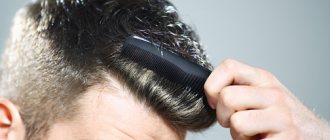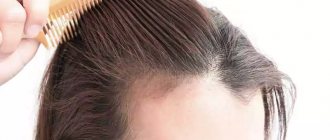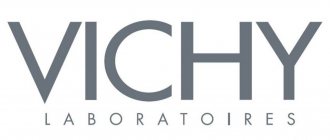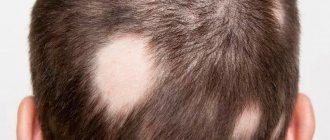Baldness or excessive hair loss, which over time leads to the appearance of pronounced bald spots mainly on the head, can affect almost anyone, regardless of their gender, age or social status. There is, of course, a stereotype (and it is justified, but only partly) that mainly men are susceptible to baldness, but this is not the absolute truth. Severe hair loss can occur in women and even children.
Most often, this is a reversible process and, if the factors causing hair loss are identified in a timely manner and corrected with the help of well-chosen treatment, then complete baldness can be avoided and, moreover, normal hair growth can be successfully restored.
Mechanism of appearance of AGA
Two types of hair can grow on our heads: regular and androgen-dependent, which die under the influence of the active form of the male sex hormone testosterone - dihydrotestosterone (DHT). DHT, in turn, is formed under the influence of the enzyme 5-alpha reductase, which is found in hair follicles and sebaceous glands. It is intrafollicular dihydrotestosterone that is the source of hair loss: it causes a strong, prolonged spasm of the vessels feeding the follicles, disrupts protein synthesis and, as a result, causes degeneration of the hair bulb and hair. In this case, the level of testosterone in the body may be normal or even reduced. Because AGA is not a disease, but a feature of the body.
The female body also contains testosterone and 5-alpha reductase, but in smaller quantities than the male body. In addition, estrogens predominate, and if the hormonal balance is not disturbed, the manifestation of AGA will become noticeable in a woman only during menopause. If hair loss began before menopause and at a young age, this is often associated with hormonal imbalance (diseases of the adrenal glands, ovaries, pituitary gland).
However, sex hormones do not always suppress or enhance hair growth. The effect of androgens or estrogens on hair is determined by the presence of special receptors on the surface of hair follicle cells. These receptors are activated by sex hormones and stimulate or block hair growth. The main cause of hair loss in AGA is either increased activity of 5-alpha reductase or increased sensitivity of hair follicle cell receptors to DHT. Therefore, there is no direct connection between age and AGA. Trichologists note that in the last few years the age of the main flow of patients is not 50-60 years old, but 25-35 years old. Moreover, cases of treatment by adolescents of both sexes aged 15-18 years with obvious signs of androgenetic alopecia are becoming more frequent.
Take the test and find out how to help your hair
Treatment of androgenetic alopecia
Minoxidil solution (2 and 5%) applied twice daily has proven effectiveness and safety. Minoxidil prolongs the duration of the hair growth phase and may increase blood flow to the follicles.
In men with AGA, the use of finasteride or dutasteride (a 5α-reductase type 1 and 2 inhibitor) has been proven effective. Can be used in women outside the childbearing period under mandatory medical supervision.
In women, various oral antiandrogen drugs (COCs, spironolactone, flutamide) are used. They should also be used under specialist supervision.
Hair transplantation is possible. It is important to understand that without proper treatment in androgen-sensitive hair follicles around the transplant area, the pathological process with the formation of new foci will continue.
Therapy with a solution or foam of topical minoxidil preparations
About 40% of patients are sensitive to therapy with solution or foam with external preparations of minoxidil. The duration of therapy to evaluate the effect is at least 3-6 months. The optimal response to treatment with this drug is demonstrated by patients with a recent onset of androgenetic alopecia and the presence of small areas of baldness. In general, women respond better to topical minoxidil treatment than men.
The use of oral antiandrogens is a more effective method of therapy (up to 60%).
Treatment must be carried out continuously throughout life, since the process is continuous.
The advantage of minoxidil is the absence of systemic effects on the body.
Oral antiandrogens are more effective, but require constant oral administration and specialist supervision.
How is androgenetic alopecia treated in the Dawn clinic
Androgenetic alopecia is the most common, but not the only cause of hair loss. Therefore, first a dermatologist or trichologist diagnoses the problem, determining the type of alopecia.
The doctor asks to tell you about the course of the disease and the treatment provided. If necessary, prescribe an additional examination (blood test for sex hormones, thyroid hormones, iron metabolism indicators) or refer you for a consultation with an endocrinologist or gynecologist.
The specialist examines the patient (primarily the scalp), evaluates the hair loss test, and performs trichoscopy. A general examination may reveal external signs of hyperandrogenism (excessive hair growth, acne).
Sometimes a skin biopsy is performed to clarify the diagnosis.
Features of AGA in women
AGA progresses more slowly in women than in men and is easier to treat. Female alopecia is characterized by general thinning of hair on the scalp, rather than baldness in specific areas, so it is more difficult to detect in the early stages - it simply reduces the overall volume. This is due to the fact that women have 40% fewer androgen receptors in the frontal region than men, as well as much more of the aromatase enzyme, which converts DHT back into testosterone and estrogens. It is a 5-alpha reductase antagonist and reduces DHT levels in the hair follicles. This explains the less pronounced nature of baldness in women. In addition, in the back of the head in women, follicles are more resistant to the effects of DHT. And, in general, the level of 5-alpha reductase in the scalp in women is approximately 3 times lower than in men, and the level of testosterone is also lower - therefore, less dihydrotestosterone is formed in the target tissues.
However, with AGA, women can also experience baldness in relation to the central parting and temples - this depends on the specific type of AGA.
Forms and complications of androgenetic alopecia
Hair loss with a typical distribution in men and women occurs differently and requires different treatment approaches. This is largely due to the identification of two forms - MPHL and FPHL.
The main signs in men: backward displacement of the frontal growth line and baldness of the crown.
In women, damage to the frontal and parietal region is typical, the hairline is usually preserved, and changes do not affect the occipital area. The progression is slower, the severity is less, and the effectiveness of therapy is higher.
Recent studies show a connection between patterned hair loss and the risk of cardiovascular diseases (myocardial infarction, stroke), insulin resistance, diabetes, high blood pressure (metabolic syndrome), and polycystic ovary syndrome. Patterned hair loss in men combined with metabolic syndrome is sometimes considered a condition related to polycystic ovary syndrome in women.
If treatment is started late, hair loss may become irreversible.
How to diagnose AGA?
According to the observations of trichologists, today androgenetic alopecia occurs in almost every second person, it just can manifest itself at different speeds and intensity. Therefore, you should carefully monitor the condition of your hair so as not to miss the onset of AGA.
How to diagnose AGA? A blood test will not give a result, since hormones and other indicators in AGA may be normal, and in more than 50% of cases, AGA occurs against the background of absolute health of the body. We remind you that the question is not about hormones as such, but about the degree of sensitivity of the follicles to them. Therefore, the best diagnosis is an examination by an experienced trichologist, trichoscopy and phototrichogram.
Symptoms of the disease
Not everyone can suspect that they have hormonal alopecia. After all, hair loss is considered an absolutely normal physiological process. However, there are certain symptoms that indicate such a pathology:
- Changes in hair structure. In place of the fallen hair follicles, soft vellus hair grows.
- Thinning hair;
- The areas of the temples and crown are more susceptible to hair loss.
Options and order of therapy for AGA.
1.
Detection of hyperandrogenism and, if present, its correction. This will require the participation of a gynecologist-endocrinologist, since the most common cause is polycystic ovary syndrome. However, we remember that hormones may be normal.
2.
Protection of hair follicles from the destructive effects of dihydrotestosterone (blocking the enzyme 5-alpha reductase). Important! What helps men (usually prescribed finasteride) does not help women! In the treatment of AGA in women, spironolactone (veroshpiron) has proven itself to be effective - it is a potassium- and magnesium-sparing diuretic with a good ability to block 5-alpha reductase. Diane-35 is also often prescribed, which is also used as an oral contraceptive - here you need to look individually at whether this treatment method is right for you. Herbal products can help - zinc, vitamin B6, dwarf palm fruit extract.
3.
Therapy for AGA must necessarily include the prevention and treatment of fibrosis, since with AGA chronic inflammation develops inside the follicles. As a result of inflammation, the connective tissue grows and microscars appear on the scalp. The scalp becomes inactive, rough, the skin is thick and dense. To begin high-quality hair restoration therapy, anti-inflammatory therapy and the fight against fibrosis are a necessary step. At home, these include peelings with acids, the use of anti-inflammatory drugs in the form of special shampoos, masks and lotions. In clinics, this also includes physical therapy using ultrasound, laser, electropheresis and other procedures.
4.
Unblocking non-functioning follicles - using hair growth stimulants. Minoxidil is usually prescribed, but it has long been known about a large number of side effects and contraindications for this drug: pronounced withdrawal syndrome, complications from the cardiovascular system, frequent itching and irritation of the scalp. Many trichologists say that the inclusion of minoxidil in the treatment regimen for AGA is no longer relevant today. Significantly more effective means, including external ones, with amino acids, peptides, zinc, estrogens, herbs, plant extracts, as well as the use of plasma therapy, ozone therapy, mesotherapy, exposure to a fractional apparatus, trichological massage. The best effect is achieved by combining several techniques.
5.
Creating the necessary conditions for hair growth and restoration - eliminating the deficiency of microelements, ensuring high-quality blood supply. This is very important, since hair follicles are extremely sensitive to these two factors. In conclusion, we would like to add that only an experienced trichologist should diagnose AGA and prescribe specific treatment. Therefore, if you are concerned about hair loss, we recommend that you immediately consult a specialist.
LEARN MORE ABOUT HAIRFOOD PRODUCTS
Hair loss
Hair loss comes in many forms and is an increasingly common complaint among dermatology patients. Some forms of scarring alopecia are also becoming increasingly common in dermatological practice. However, today, androgenetic alopecia (AGA) is widespread among men and women. The frequency of AGA varies among different ethnic groups, but in general, up to 70% of men and 40% of women experience AGA to one degree or another in their lives. Negative perceptions of their appearance force affected individuals to seek optimal diagnostic and treatment options.
Androgenetic alopecia
Clinical manifestations
In most men, AGA develops with a characteristic “pattern” of hair loss areas. In women, the manifestations of AGA may be less pronounced. progressive thinning of hair, As a rule, women experience diffuse thinning of hair, which is observed primarily in the frontal, parietal regions, and superotemporal scalp, although the frontal hairline is preserved. Sometimes women with excess androgen production may develop male-type AGA. It should also be noted that frontal fibrosing alopecia in women is often misdiagnosed as AGA. Diffuse AGA may be difficult to distinguish from telogen effluvium. Indeed, increased telogen hair loss may be characteristic of the early phase of AGA. If the diagnosis is in doubt, a biopsy is indicated.
Biochemistry
A study of patients with androgen insensitivity syndrome or 5α reductase deficiency suggests that AGA is induced through activation of androgen receptors in hair follicles by dihydrotestosterone (DHT). DHT binds to androgen receptors five times faster than testosterone and therefore has a greater ability to activate them. The two different forms of 5α reductase (types 1 and 2) differ in their tissue distribution. Type 2 is most active in hair follicles and is most likely to contribute to AGA. The main precursor of DHT in men is testosterone, and dehydroepiandrosterone (DHEA) and other weaker androgens are precursors for DHT in women. The intracellular cascades triggered by androgen receptor binding to DHT are poorly understood, but receptor binding results in increased production of cytokines such as TGF beta 1 and 2, which promote telogen and senescence signals for hair papillary cells. The density of androgen receptors in hair follicles varies by location. Occipital hair follicles, with a small number of androgen receptors, practically do not respond to DHT. Consequently, hair loss is mainly limited to the parietal and frontotemporal regions.
Genetics and diagnostic tests
The susceptibility to AGA is largely determined by genetics, although the environment may also play a minor role. Polymorphism of androgen receptors likely determines their sensitivity to androgens, but genes associated with 5α reductase, aromatase, and sex hormone binding globulin (SHBG) also have a significant influence. While the full genetic picture is unclear, at least one company claims (HairDX™) that it is working to develop a gene polymorphism diagnostic test that will be able to predict the chances of further development of AGA. For young patients concerned about hair loss, this test can help determine the value of early treatment. Perhaps of greater immediate practical relevance is a test that can predict response to finasteride treatment in women. Thyroid-stimulating hormone levels help rule out thyroid dysfunction. Free testosterone is assessed when androgen excess is suspected. A serum ferritin test can be used to determine serum iron deficiency. If serum ferritin is insufficient, iron supplements are indicated to promote response to other treatments.
Current and future treatments
Drug therapy recommended for the treatment of AGA is limited to minoxidil and finasteride. Both drugs can be used in combination. Some other drugs are also used to treat AGA (see below), but do not have a sufficient evidence base and do not exclude claims of hair growth from patients. An analysis and development of evidence-based guidelines for the treatment of AGA in men and women has recently been published, which may help guide treatment decisions.
Minoxidil
Minoxidil (Rogaine®) was originally intended for antihypertensive therapy, but was subsequently developed as a topical treatment (in available 2% and 5% solutions) for hair loss. Minoxidil use is associated with vasodilation, angiogenesis, and its ability to increase cell proliferation, likely mediated through potassium channels. Side effects include contact dermatitis and increased hair loss early in treatment. The use of 5% minoxidil in the form of a new vehicle foam, which does not contain propylene glycol, which has an irritating effect, is better tolerated by patients. Some medications that include minoxidil are sometimes available in combination with other active ingredients such as tretinoin and can be purchased from various manufacturers in the United States.
Finasteride
Finasteride (Propecia®) is the most common treatment for AGA. It is a synthetic type II 5α reductase that reduces the conversion of testosterone to DHT. An increase in hair growth and thickness can be observed within 6 months - 1 year with a daily dose of 1 mg. Adverse sexual events have been reported more frequently with finasteride having adverse effects on sexual function. Finasteride has significant and adverse effects on the development of male embryos and is not officially approved for use in women. However, it can be used for AGA in combination with effective oral contraceptives. Small-scale studies suggest that it may be effective in women with elevated androgen activity.
Dutasteride
Dutasteride (Avodart®), a type I and II 5α reductase agent, is in phase III trials for AGA. Currently approved for the treatment of benign prostatic hyperplasia. A phase II study for AGA demonstrated a dose-dependent increase in hair growth. The efficacy of dutasteride at a dose of 2.5 mg/day was higher than that of finasteride at a dose of 5 mg/day. Side effects are similar to finasteride.
Prostaglandin analogues
The prostaglandin F2 analogues latanoprost and bimatoprost are used in the treatment of ocular hypertension and glaucoma. There has been a reported side effect of increased eyelash hair growth, which has been investigated in several small studies. Bimatoprost (Latisse®) is now available as an eyelash growth treatment. Recently, the scalp hair growth potential of latanoprost (Xalatan®) has been investigated. Latanoprost significantly increased hair density compared to baseline and placebo, and also stimulated pigmentation.
Ketoconazole
A topical shampoo containing 2% ketoconazole (Nizoral®) is available over the counter, while higher concentrations are available by prescription only. As an imidazole antifungal agent, ketoconazole is effective in the treatment of dermatitis and dandruff, and its action on the scalp microflora may benefit AGA associated with follicular inflammation. However, ketoconazole also has antiandrogenic effects and has been suggested to improve hair growth in AGA via androgen-dependent pathways. Ketoconazole shampoo is usually used in combination with other topical medications to treat AGA.
Antiandrogens
Several synthetic antiandrogens can be used as inhibitors of 5α-reductase activity and can also block binding to the androgen receptor. The effectiveness of topical antiandrogen compounds in AGA has been investigated in some small studies, but they are not usually considered as monotherapy. More often, antiandrogens are used in combination with estrogens to treat FPHL. Treatment approaches using oral antiandrogens are significantly more popular in Europe than in North America. Cyproterone acetate, available in Canada but not the US, has been used in FPHL with some effect. However, in North America, spironolactone is generally the preferred oral antiandrogen.
Estrogens
Estrogens are indirect antiandrogens and are sometimes used to treat AGA in women in the form of birth control pills. When used systemically, estrogens increase the production of SHBG, which binds to androgens, including testosterone, reducing their bioavailability. Topical estrogen compounds are also available in Europe. It is believed that topical estrogens may act on estrogen receptors in hair follicles to promote hair growth, either directly or by antagonizing androgen activity. However, there are currently a lack of large clinical studies demonstrating the effectiveness of topical estrogens, and estrogen preparations for the topical treatment of AGA are not generally available in North America.
Laser processing
The use of laser light to treat hair loss has become very popular in the last few years. It is also used as a preventive measure against AGA. Several different manufacturers provide lasers and light sources of different wavelengths and with different uses. While some laser machines are designed for daily use at home, others are only available in clinic settings for weekly or monthly use. While there is evidence that laser beam can stimulate hair growth at some wavelengths, the biological mechanism by which it occurs has not been determined. There is also a lack of large-scale clinical studies. Despite some positive results in AGA, laser technology has not yet become a significant treatment approach in most dermatological clinics.
Surgical intervention
Hair follicles on the scalp at the back of the head are relatively resistant to the effects of androgens. This allows them to be transplanted into balding areas with AGA. Significant advances have been made using surgical methods of hair restoration. Follicular unit transplantation (FUT) is the most accessible hair transplant technique in clinics in North America and beyond. More recently, specialized methods for transplanting hair follicles have been developed and the FUE machine has been developed, allowing a group of follicles to be transplanted simultaneously without the risk of scarring. Hair transplant costs range from $5,000 to $20,000 per treatment, and sometimes more, depending on the number of grafts and the cost of the surgeon. Depending on the extent of hair loss, one or two hair transplant sessions may be required. Surgical treatment is limited by the density of the hair in the area where the donor hair is taken and the reluctance of some patients to undergo a fairly invasive procedure.
Cell therapy
Efforts by several companies and academic research groups are focused on developing cell-mediated treatments for AGA. Two main approaches are used: direct injection of cultured cells into bald areas or the use of hair growth-stimulating factors secreted by the cells. It has been shown that cells from the mesenchymal tissues of the hair follicle can be cultured and then used to induce the formation of new hair follicles in the epithelial tissue. The injected cells may also migrate to nearby hair follicles to increase their size. On the other hand, the cells produce compounds rich in hair growth-promoting factors, such as Wnt proteins, which can be used for treatment. These treatment approaches are still in phase I-II trials but may become available within the next few years. It should also be noted that platelet-rich plasma (PRP), isolated from whole blood, is currently gaining popularity in the market. Platelets produce many different growth factors as well as other potentially stimulatory mediators. Some hair transplant surgeons use this product to stimulate the growth of transplanted grafts. PRP is also available in some clinics as a stand-alone treatment for AGA, although there is still only one small published study to support this approach.
Alternative Treatments
Numerous products sold directly to the consumer contain mixtures of botanicals, vitamins and minerals, although there is no independent evidence to support them as hair growth promoters. Some of the most common herbs that patients may take include saw palmetto (Serenoa repens), crowberry (Actaea racemosa), seaweed (Angelica sinensis), false unicorn (Chamaelirium luteum), chasteberry (Vitex agnuscastus), and red clover (Trifolium pratense), which are said to have antiandrogenic or estrogenic activity. Other products may contain biotin, caffeine, melatonin, copper complexes, as well as various compounds with different purported modes of action.
Conclusion
Overall, there are currently a number of treatment options for people with AGA, although clinical evidence to support their use is often very limited. Finasteride and minoxidil are still the most common therapeutic agents available for AGA. New treatment approaches are the subject of active study.











